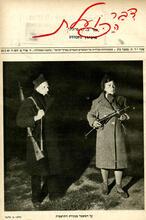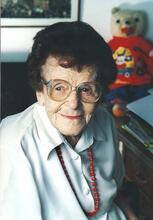Devorah Dayan
Devorah Dayan (née Zatolowsky) was born in Ukraine in 1890 to the only Jewish family in her birthplace. In her early life, her connection to the Jewish people was tenuous, but she felt a strong pull towards the people of Russia. Until 1912 she was engaged in Russian affairs and society. Dayan then immigrated to Erez Israel and began her agricultural training. The difficulties of acclimating were lessened when she became involved with her later husband, Shemuel Dayan. The couple was among the founders of the first workers’ moshav. Dayan began her long writing career as she became frustrated with her living and working situation. Her writing was valuable to the women workers’ movement, as she was a symbol of the new Hebrew woman.
“All the links in the chain of Devorah’s life cast a light of great activity and influence on her surroundings, both near and far. Love of her motherland was the main force behind all her writings (and actions) and intermingled with everything: home, village, motherhood, the farm, teaching new immigrants and their children, the fate of her sons in battle and her bereavement.” Thus Rahel Katznelson-Shazar eulogized the new Hebrew woman as exemplified by Devorah Dayan.
Early Life and Connection to Russia
Devorah Zatolowsky was born in the Ukraine on September 23, 1890, to the only Jewish family in her birthplace, the village of Prochorovka in the Poltava district. Her father, Yehiel Ze’ev, a successful lumber merchant, was a broad-minded Zionist who wrote in Hebrew and Russian. Until she was eight years old, Devorah studied at home with a private tutor, afterwards attending the village school, the Russian gymnasium in Kremenchuk, and the department of pedagogy at the University of Kiev. Her connection to the Jewish people was tenuous because of the type of education she had received and also because of her ignorance of the religious practice customary in traditional Jewish society. She loved the people, language, and literature of Russia.
During the 1905 revolution she joined the Narodniki people’s liberation movement despite her youth, and was active in the districts where factory workers lived. While at university, she joined the students’ faction of the Social-Democratic Party and worked on their behalf in the Caucasus and Crimea. In 1910 she joined the funeral procession of her favorite author, Leo Tolstoy (1828–1910). This journey, which took several days, was an expression of her love for Russian literature and her feeling that she was a full participant in the life of the Russian people. It was an important milestone in her life, and even a generation later she recalled her feelings at the time: “In every person’s life, there is a moment when he wants to tell the sun to stand still. For me, this was such a moment.”
In 1911, during the war in the Balkans, Dayan left her university studies to volunteer as a nurse for Russian soldiers at the Bulgarian front. Paradoxically, it was there that she began to doubt her connection to the Russian people and after repeated urging from her parents she left Sofia to return to the Ukraine. She resumed her studies at university and worked part-time for the Kiev local government in the Zemstvo government aid organization. However, the doubts and sense of alienation she experienced among her Russian colleagues grew gradually stronger and she sought a new path. Many years later, she wrote of that time: “I was mistaken then. The nation to which I wished to devote my strength was not my own, and I was a stranger within it.” Her crisis of identity led her to leave her university studies and return to her parents’ home. Throughout 1912 she thought about her national identity, finally acknowledging her roots and deciding to travel to The Land of IsraelErez Israel. Her family, though Zionist, had many reservations about her decision. The trip and subsequent acclimation to a strange and desolate land were risky, especially for a young woman on her own. But she was steadfast in her decision and in January 1913 sailed from Odessa to Erez Israel. She was alone both on the week-long journey and on her arrival.
Work in Erez Israel
After her first few days in the country, Dayan arrived by chance at A voluntary collective community, mainly agricultural, in which there is no private wealth and which is responsible for all the needs of its members and their families.Kevuzat Deganyah. The members of the group were not enthusiastic about her decision to join the pioneer community. In addition, the members of Deganyah, whom she wished to join, were—like the director of the Jewish Colonization Association, where she wished to receive agricultural training—skeptical of her ability to do the work required of her. Her delicate physical appearance, her past involvement in Russian society, her broad education and ignorance of Hebrew, all made her seem alien and they were convinced that she was unfit for a life of manual labor and cooperation.
The difficulties of acclimation to Erez Israel also caused her to begin doubting her decision. She continued to be attached to Russian literature, still did not learn Hebrew, and found it difficult to adopt the prevalent social values, especially regarding manual labor, which was perceived as a form of human redemption. However, in Deganyah she met Shemuel Dayan (1891–1968) and their love was balm to her heart. Fully a part of pioneer society, he supported and guided her until they decided to become engaged. She then returned to Deganyah, where she was well received on his account. Shortly afterward, they decided to return to Europe for medical treatment. They left Palestine in December 1913 and returned in August 1914, once more against her parents’ wishes. Devorah and Shemuel were married in September 1914; their eldest son, Moshe (1915–1981), the first child born in Deganyah, was born the following year.
The first years of motherhood were difficult for Dayan, who had to balance parenting with work at a time when both family patterns and children’s education among the Synagogue cantorhalutzim were as yet unformed. The existential difficulties during wartime also left their mark, along with the relentless tensions arising from food shortages and various illnesses.
With the war’s end, after much wavering (more on her part than on Shemuel’s), they left Deganyah to establish another kind of community, the Cooperative smallholder's village in Erez Israel combining some of the features of both cooperative and private farming.moshav. After two and a half years of wandering, they were among the founders of the first workers’ moshav, Nahalal, in the Jezreel Valley. During the waiting period before the establishment of the moshav, Shemuel embarked on public activity that would last many years, while Dayan had to cope, as she did many times, with loneliness and hardship. Their daughter Aviva was born in 1922. Tent living and life’s burdens led to a decline in Devorah’s health, which she never fully regained. Nevertheless, she did not refrain from hard work at home and on the moshav. Shemuel, who built the farm and invested much effort in its development, preferred public activity, which caused him to be absent from home and from the moshav and frequently interrupted his involvement in daily life. Dayan bore the burden of the farm alone, with help from her son Moshe and occasional hired laborers. Since Shemuel’s work took him to all parts of the country and even abroad, he was absent during the birth and Circumcisionbrit milah of his third child, Zohar (1926–1948). At first, Devorah supported his public activity, but when funds ran short and she could no longer bear the double burden of home and work, she changed her mind. She was especially bitter about the fact that she could not fulfill her own desire to engage in public activity and writing. Her life and Shemuel’s began to diverge, with hers full of physical and emotional effort as she sought to follow her heart’s inclinations within the narrow confines of her life.
Writing Career
In the evenings after a long, exhausting day’s work, she read and wrote a great deal. Her essay, “My Lit. "ascent." A "calling up" to the Torah during its reading in the synagogue.Aliyah,” was published in Devar ha-Po’elet, the organ of the women workers’ movement, edited by Rahel Katznelson. This was the beginning of her long writing career, at first in Russian and later on in Hebrew. Most of her writings were published in Devar ha-Po’elet. While not the writing of a great artist, it bore a personal echo of settlement life. The essays were brief and mostly autobiographical, but they also included descriptions of personal feelings and literary criticism. Dayan was a member of Devar ha-Po’elet’s editorial staff from its first year of publication until her death. The editor, Rahel Katznelson, considered her participation as vital to the editorial board and her writing as especially valuable. She appreciated Dayan’s contributions to the magazine primarily because she perceived her as a symbol of the new Hebrew woman—maternal, rooted in the land and fulfilling the values of pioneer society. Besides contributing to the newspaper, Dayan was a member of the women workers’ council and active in Ha-Po’el ha-Za’ir (later Mapai) and in immigrant absorption. But the awareness that her time was limited and that she could not absent herself from her home or the farm cast a shadow over all her activity. The meetings of Devar ha-Po’elet’s editorial board took place only once a month, and most of the consultations and decisions were carried out by correspondence. Throughout her years of activity, the house at Nahalal was her home and the focus of most of her work. She alternated between remorse at absenting herself from work and frustration and disappointment over not fulfilling her aspirations. She was devastated by the death of her younger son, Zohar (Zorik), during the War of Independence. From then until the day of her death, she immersed herself in work for the new wave of immigration, especially in teaching Lit. "Eastern." Jew from Arab or Muslim country.Mizrahi women on new moshavim.
Devorah Dayan died of cancer on July 28, 1956.
Selected Works by Devorah Dayan
I Shall Tell (Hebrew). Tel Aviv: 1952.
In Joy and Sorrow (Hebrew). Tel Aviv: Masada-Moshav Movement, 1958.
Dayan, Devorah. I Shall Tell (Hebrew). Tel Aviv: 1952.
Idem. In Joy and Sorrow (Hebrew). Tel Aviv: 1958.
Dayan, Shemuel. On the Banks of the Jordan River and the Sea of Galilee (Hebrew). Tel Aviv: no year given.
Gefen, Yehonatan. A Dear Woman (Hebrew). Tel Aviv: 1999, 80–94.
Katznelson-Shazar, Rahel. “Devorah Dayan.” In Those Who Were with Me and Are Gone (Hebrew). Tel Aviv: 1969, 27–30.
Tevet, Shabbetai. Moshe Dayan: A Biography (Hebrew). Jerusalem and Tel Aviv: 1971.





